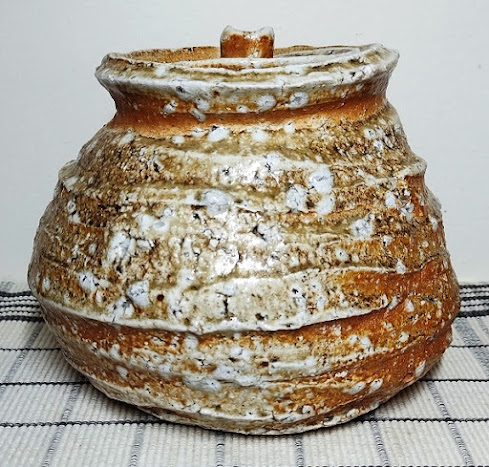236. HASHIMOTO Tomonari 橋本知成, 1990- , “untitled,” truncated cone sculpture, 2023
Hashimoto Tomonari was born in Wakayama Prefecture, the son of a sculptor. In 2012, he graduated from the Kyoto University of Education, where he majored in Fine Arts. He began studying ceramics in his junior year. He received a master’s degree from the Kanazawa University of Art in 2014, and a Ph.D, in 2017. After graduation he became an artist-in-residence at the Shigaraki Ceramic Cultural Park, which allowed him to pursue his goal of creating larger works. He now lives in Shigaraki. He has participated in and been selected to be a part of numerous group exhibitions and competitions and has had several solo exhibitions. His works are part of the collections of the Victoria and Albert Museum in London, Los Angeles County Museum of Art, LOEWE Foundation in Madrid, Korea Ceramics Foundation, and Shigaraki Ceramic Cultural Park, as well as several hotels in Japan.
He forms each piece through hand-building, shaping, and paddling. The piece is then bisque-fired and glazed. Using fire bricks, he builds a kiln around each object (or collection of smaller objects) and heats the kiln to around 1000-1100 degrees Celsius. He then dumps in millet or rice husks, which carbonize on the surface and in combination with the metals in the glaze create iridescent colors in random patterns.
A statement from Hashimoto: "Everything is simple in essence. Humans, or the society we create, can complicate or obstruct our ability to see these essences. The process of creation is a time for me to discipline myself, to face my inner self. I believe it is paramount to allow oneself time to behold the essence of things and through that observation to face oneself."
White clay, with kiln-effect colors in the red, brown, and black ranges. Weight: 2.7 kg (6 lb). Height: 24.7 cm (9-3/4 in). Width: top, 18 cm (9-3/4 in); maximum, 26 cm (10-1/4 in), base, 4.8 cm (1-7/8 in).
This is very symmetrical; any given cross-section would be a near-perfect circle. It is a truncated cone in shape, much like a traditional gemstone. It sits on a flat base. The base has a small hole in the center to allow air to escape during the firing process. From the base, the walls rise upward and outward in a straight line to the maximum width, which is 16.7 cm (6-5/8 in) above the base. From there the walls move upward and inward, again in a straight line, to the circular top. The exterior surface is covered with many small, irregular, shallow grooves and pits. They look almost as if bits of the surface had flaked off.
The interaction of the glaze and the carbonization of plant materials left this colored black and a deep russet color. The base was left unglazed and was largely unaffected by the final firing process.
This came in a box, inscribed in roman letters “UNTITLED” and “Tomonari,” followed by the artist’s seal stamped in red. Hashimoto does not give his works titles, and all the boxes I have seen are inscribed “untitled.” Included in the box was a white wrapping cloth.
Unfortunately, because of the narrowness of the base in contrast to the size and weight of the structure above it, this does not sit firmly on the base. It would be unwise to leave it where the even a slight jostling would tip it onto its side.
Purchased
from the Kara Monzen Gallery in Kyoto, Japan, in November 2023. The Gallery
hosted a solo exhibition of Hashimoto’s works in November-December 2023. The
Gallery included a copy of the exhibition booklet with the work.





















